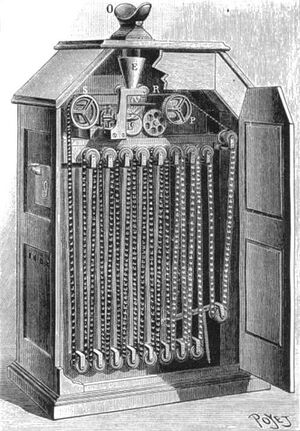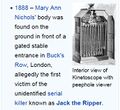Kinetoscope (nonfiction): Difference between revisions
Jump to navigation
Jump to search
(Created page with "300px|thumb|Interior view of Kinetoscope with peephole viewer at top of cabinet.The '''Kinetoscope''' is an early motion picture exhibition device. T...") |
No edit summary |
||
| (One intermediate revision by the same user not shown) | |||
| Line 7: | Line 7: | ||
== In the News == | == In the News == | ||
<gallery | <gallery> | ||
File:Jack the Ripper kinetoscope.jpg|Kinetoscope may hold key to identity of Jack the Ripper. | File:Jack the Ripper kinetoscope.jpg|Kinetoscope may hold key to identity of Jack the Ripper. | ||
</gallery> | </gallery> | ||
| Line 14: | Line 14: | ||
== Nonfiction cross-reference == | == Nonfiction cross-reference == | ||
* [[Hannibal Goodwin (nonfiction)]] | |||
* [[Thomas Edison (nonfiction)]] | |||
External links: | External links: | ||
Latest revision as of 16:38, 6 July 2017
The Kinetoscope is an early motion picture exhibition device.
The Kinetoscope was designed for films to be viewed by one individual at a time through a peephole viewer window at the top of the device.
The Kinetoscope was not a movie projector but introduced the basic approach that would become the standard for all cinematic projection before the advent of video, by creating the illusion of movement by conveying a strip of perforated film bearing sequential images over a light source with a high-speed shutter.
In the News
Fiction cross-reference
Nonfiction cross-reference
External links:
- Kinetoscope @ Wikipedia

